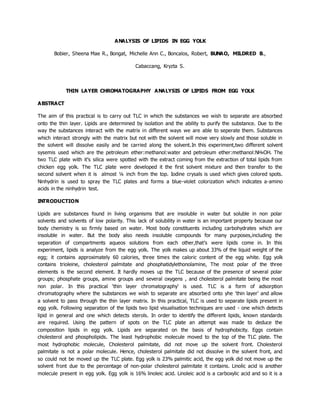
Analysis of lipids in egg yolk
- 1. ANALYSIS OF LIPIDS IN EGG YOLK Bobier, Sheena Mae R., Bongat, Michelle Ann C., Boncalos, Robert, BUNAO, MILDRED B., Cabaccang, Kryzta S. THIN LAYER CHROMATOGRAPHY ANALYSIS OF LIPIDS FROM EGG YOLK ABSTRACT The aim of this practical is to carry out TLC in which the substances we wish to separate are absorbed onto the thin layer. Lipids are determined by isolation and the ability to purify the substance. Due to the way the substances interact with the matrix in different ways we are able to seperate them. Substances which interact strongly with the matrix but not with the solvent will move very slowly and those soluble in the solvent will dissolve easily and be carried along the solvent.In this experiment,two different solvent sysemis used which are the petroleum ether:methanol:water and petroleum ether:methanol:NH4OH. The two TLC plate with it’s silica were spotted with the extract coming from the extraction of total lipids from chicken egg yolk. The TLC plate were developed it the first solvent mixture and then transfer to the second solvent when it is almost ¼ inch from the top. Iodine crysals is used which gives colored spots. Ninhydrin is used to spray the TLC plates and forms a blue-violet colorization which indicates a-amino acids in the ninhydrin test. INTRODUCTION Lipids are substances found in living organisms that are insoluble in water but soluble in non polar solvents and solvents of low polarity. This lack of solubility in water is an important property because our body chemistry is so firmly based on water. Most body constituents including carbohydrates which are insoluble in water. But the body also needs insoluble compounds for many purposes,including the separation of compartments aqueos solutions from each other,that’s were lipids come in. In this experiment, lipids is analyze from the egg yolk. The yolk makes up about 33% of the liquid weight of the egg; it contains approximately 60 calories, three times the caloric content of the egg white. Egg yolk contains trioleine, cholesterol palmitate and phosphatidylethonolamine, The most polar of the three elements is the second element. It hardly moves up the TLC because of the presence of several polar groups; phosphate groups, amine groups and several oxygens , and cholesterol palmitate being the most non polar. In this practical 'thin layer chromatography' is used. TLC is a form of adsorption chromatography where the substances we wish to separate are absorbed onto yhe 'thin layer' and allow a solvent to pass through the thin layer matrix. In this practical, TLC is used to separate lipids present in egg yolk. Following separation of the lipids two lipid visualisation techniques are used - one which detects lipid in general and one which detects sterols. In order to identify the different lipids, known standards are required. Using the pattern of spots on the TLC plate an attempt was made to deduce the composition lipids in egg yolk. Lipids are separated on the basis of hydrophobicity. Eggs contain cholesterol and phospholipids. The least hydrophobic molecule moved to the top of the TLC plate. The most hydrophobic molecule, Cholesterol palmitate, did not move up the solvent front. Cholesterol palmitate is not a polar molecule. Hence, cholesterol palmitate did not dissolve in the solvent front, and so could not be moved up the TLC plate. Egg yolk is 23% palmitic acid, the egg yolk did not move up the solvent front due to the percentage of non-polar cholesterol palmitate it contains. Linolic acid is another molecule present in egg yolk. Egg yolk is 16% linoleic acid. Linoleic acid is a carboxylic acid and so it is a
- 2. polar molecule, hence linoleic acid was carried along the solvent front on the TLC plate. Egg yolk displays hydrophobicity as it's non-polar components are dominant over the polar parts. This is why egg yolk was not carried up the solvent front. Lipid Molecular Structure EXPERIMENTAL A. Materials Needed TLC Solvent Mixtures: Petroleumether:methanol:NH4OH Petroleumether:methanol:water (65:25:4) (65:25:4)
- 3. Ninhydrin Spray Iodine Crystals B. PROCEDURE Equilibrate the TLC solvent mixtures in two separate beakers: (a.) 65:25:4 (v/v/v) petroleum ether:methanol:water (b.) 65:25:4 (v/v/v/) petroleum:ether:methanol:NH4OH. Place two clean TLC plates on the hot plate with silica side up for approximately 3minutes to reactivate silica.Remove TLC plates from heat. Spot the extract (from the extractin of total lipids from chicken egg yolk) at least 1cm from the edge of the TLC plates.Develop the plate in the first solvent mixture 65:25:4 (v/v/v) petroleum ether:methanol:water.Remove the TLC plates when the solvent front is almost ¼ inch from the top and transfer them to the second solvent mixture 65:25:4 (v/v/v) petroleum ether:methanol:NH4OH. Put I2 crystals in a separate beaker and saturate the container with I2 vapor for 5 minutes. Transfer the TLC plates in the beaker with iodine until spots appear. Place the plates on a hot plate to remove excess I2. Completely spray the TLC plates with ninhydrin. Place them on the hot plate for 1minute. A blue-violet colorization indicates the presence of a-amino acids in the ninhydrin test.Completely spray the plates with phosphorus. Place them on the hot plate for 30 seconds. Phosphorus containing compounds will appear as blue spots on white background. Additional heating will char unsaturated compounds.
- 4. Resultsand Discussion Figure a: Placing the filter paper inside Figure a1: Placing the TLC plates the beaker to determine if the solvent on the hot plate with silica side up is now ready to calibrate with the to reactivate silica. chamber. Figure a2: Two TLC plate inside the Figure 2: With Iodine crystals beaker with its spot from the extraction inside. of total lipids from chicken egg yolk.
- 5. Figure 2a: Spots appear after saturating Figure 2b: Results after spraying with Iodine. with ninhydrin. Figure 3: Final results after placing on the hot plate.